The satisfaction of growing one’s own food can almost – not quite, but almost – be matched by the satisfaction of finding one’s own food.
For me, it began with the raspberries. Indeed, raspberries are perhaps my rampion: like Rapunzel’s mother, I crave them above all other foods. The first thing we did when we bought a house, before we painted a single wall or moved a single stick of furniture, was to build a raised bed and plant three raspberry canes. They all died by summer’s end, apparently of ennui.
But wild brambles are of a more robust disposition, it turns out. I found them clinging to a hillside in Wales. I found them surrounding a soccer field in Syracuse. I found them in the pine plantations and state game lands here in Pennsylvania. I was once caught hanging over a stranger’s stone wall, picking from his neglected-but-thriving bramble canes (and instead of being relieved of my firstborn child, I was offered a job in a bookstore – but that’s another story entirely). These days, I carry a small rucksack with a water bottle for the dog and a plastic box for the berries.
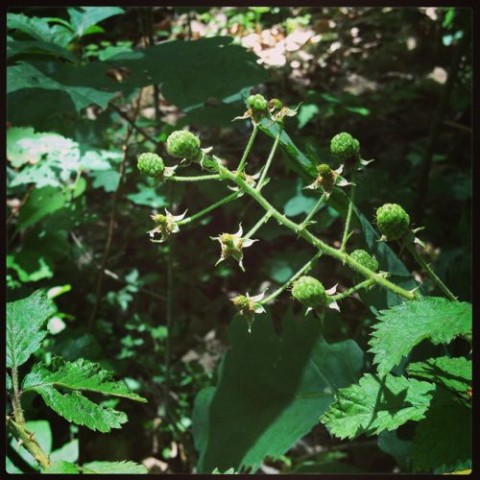
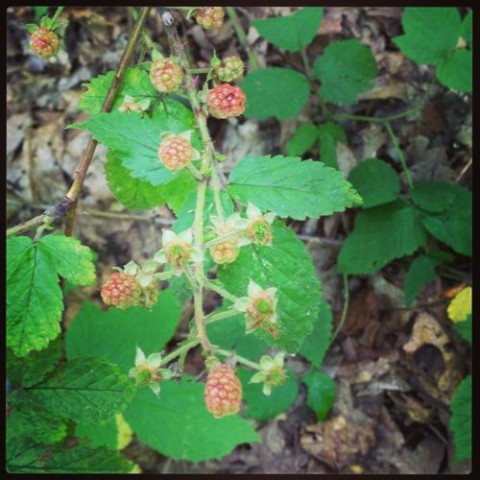
Now, the first rule of foraging is: don’t expect your harvest to taste like something from the supermarket. The black raspberries I find in the woods are smaller, harder, and less sweet than cultivated raspberries are. They are tart and bright on the tongue, like hibiscus. They are delicious in desserts, and they do good things to gin (including turning it a lovely shade of purple). Their family is Rosaceae (rose) and the genus Rubus (red!) covers all the fruiting brambles: blackberries, red and black raspberries, dewberries, wineberries, and many others – all edible, all delicious.
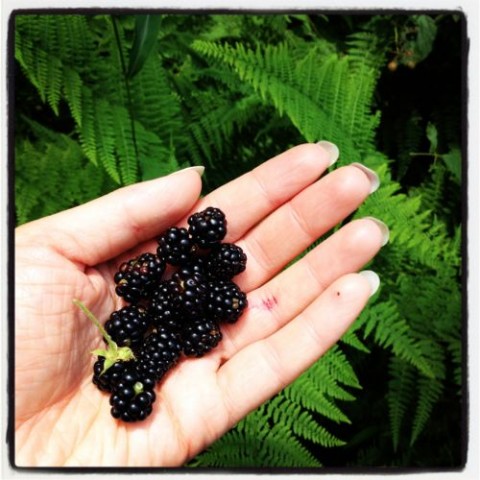
The second rule of foraging is: brambles and garlic mustard greens and sweet peas and poison ivy all like the same habitat, at the sunny edges of paths and fields and woods. Garlic mustard and poison ivy even have similar serrated leaves — one tasty, one itchy. Be careful. Wear boots.
The third rule of foraging is: don’t eat it if you don’t know what it is. Brambles are easy to identify, and wild strawberries are not difficult, but I do not eat any other wild berry. Unripe holly berries, for instance, look a bit like huckleberries or blueberries. But just a few will give you cramp, or worse. Never eat a foraged mushroom. Just don’t. Not any, not ever. Not unless you are a mycologist – and maybe not even then. Many species of fungus are toxic, some severely so, and many are very difficult to tell apart, such as the Russula and the Lactaria, two similar fungi that can only be definitively identified when one is broken – the Lactaria ooze a milky fluid, and the Russula do not.
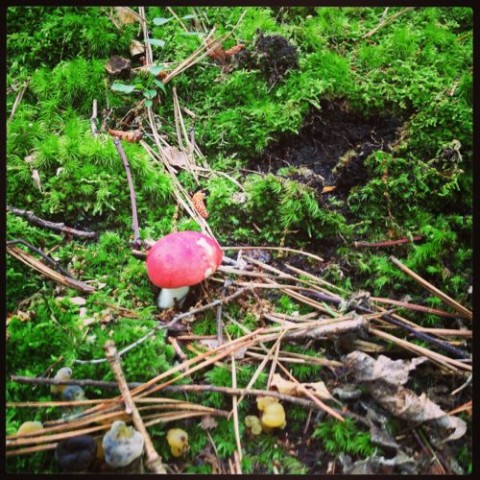
Mushrooms are misleading things, with their pretty caps and poisonous flesh.
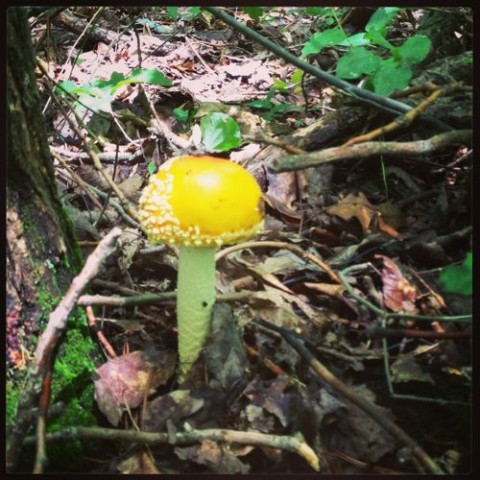
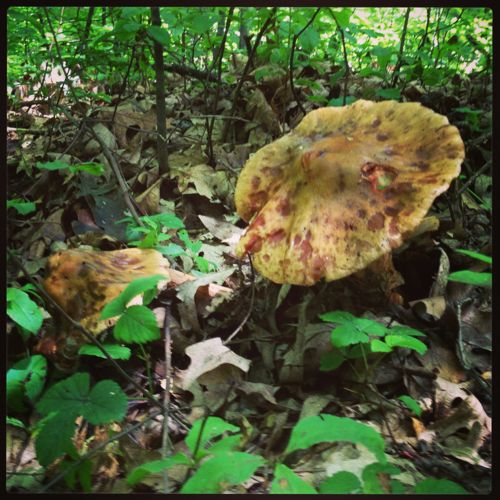
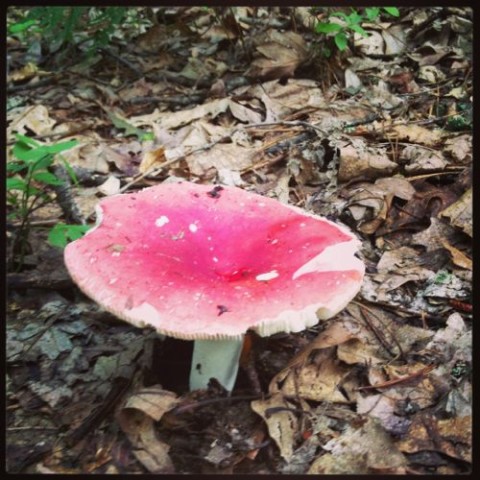
The fourth and final rule of foraging is: watch your dog. Let your dog show you where NOT to harvest. If you don’t have a dog, recall that other people do. Dogs and foragers frequent the same margins.
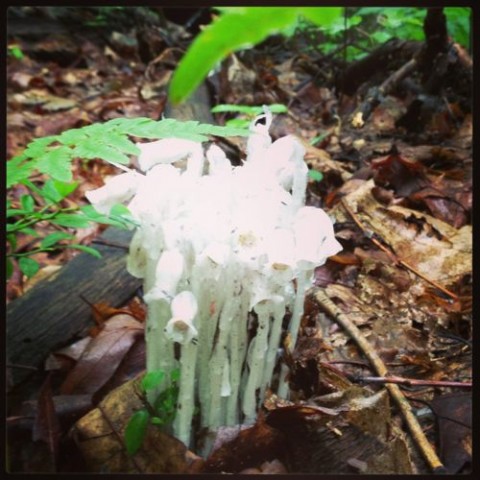
As you may divine from my numerous pictures of fungi and frequent mention of dogs, I spend a lot of time in the woods. How often you forage and how far is entirely a matter of choice; I let convenience dictate, but I try to be prepared by carrying boxes, scissors and citronella oil with me. The smartphone is a wonderful tool for foraging, by the way, since it provides a ready reference. It’s also my hiking camera, so the snapshots for this post were taken with my phone and Instagramated, excepting only this one:
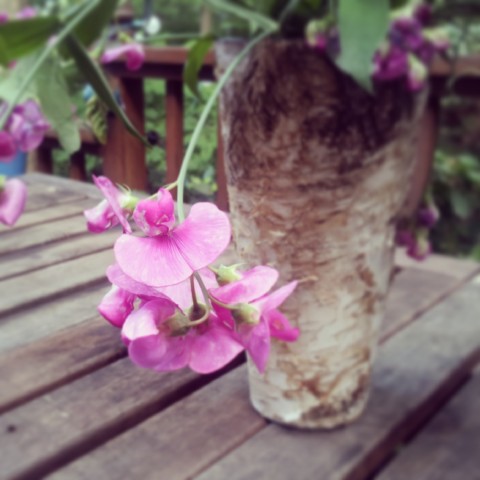
I come home with photos more often than flowers, and flowers more often than food.
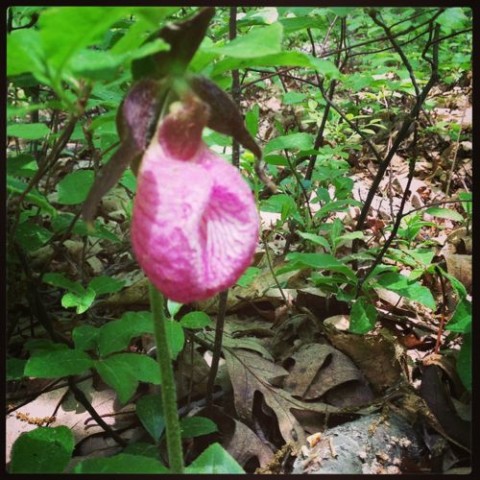
The flowers you find in the woods or at the roadside are just as beautiful as hothouse blooms, and they were not treated with pesticides or shipped halfway across the country. I love wild azalea and sweet peas in the spring, sunflowers in the summer, Queen Anne’s lace… Even the easiest to find include many edibles, like dandelions (greens), Queen Anne’s lace (root), and violets (flower).
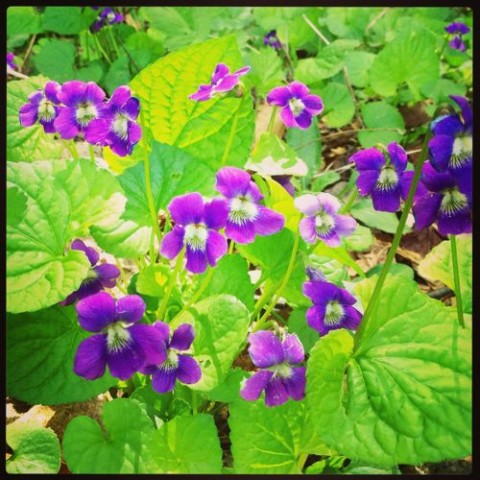
To candy your violets, make a thin simple syrup and let it cool. (You may wish to stir a bit of rosewater into it.) I wouldn’t wash the violets, because they are too delicate. Using the stem as a handle, dip each flower into the syrup and lay it on a piece of parchment paper or a wire rack. Sprinkle them with sugar while they are still moist, and then allow them to dry undisturbed for a full day. Clip off the stems with sharp scissors and scatter the violets on a special salad or a fancy cake.
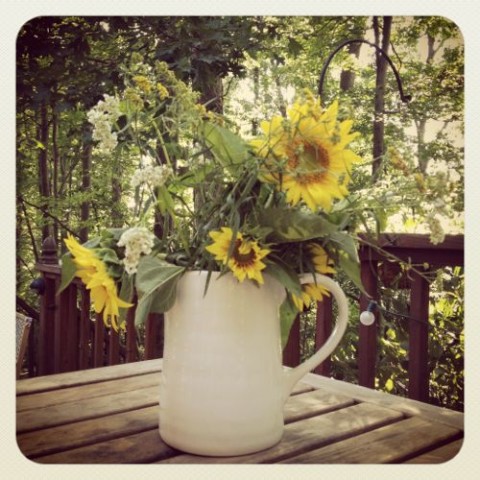
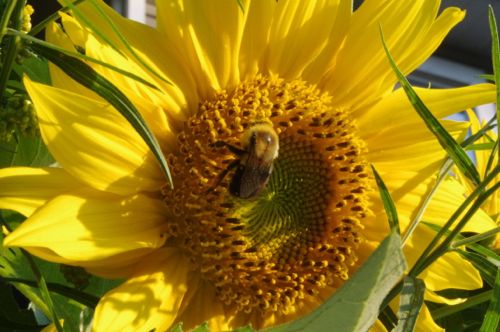
In the past, I’ve filled my freezer with berries and my tables with vases of trailing sweet peas. But nowdays, I look most assiduously for garlic mustard greens. Have you not heard of them? I hadn’t either, until a dog-walking friend pointed them out as a curiosity. “Crush the leaf – don’t they smell like garlic?”
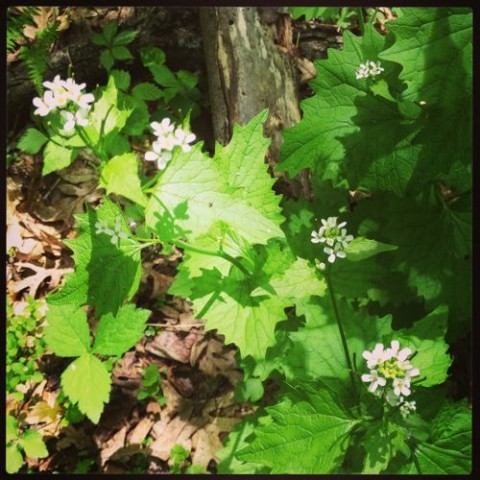
Indeed they do: pungent, bitter, and distinctly garlicky. Alliaria petiolata are members of the mustard family, but the name means “related to garlic”. Furthermore, the long taproot smells and tastes like horseradish. They grow at the sunny edges of woods and fields, giving rise to the names Jack-in-the-hedge and Hedge Garlic, as well as the apt Sauce-alone. They have a two-year growth cycle, and the leaves apparently taste differently in the first and second year – but I only harvest the second, because it’s easier for me to recognize, with its tall stems, jagged leaves, and white cross-shaped flowers. Once you learn to see them, you will see them everywhere: I harvested my last batch in a gully behind a mechanic’s shop while my husband was discussing headlights.
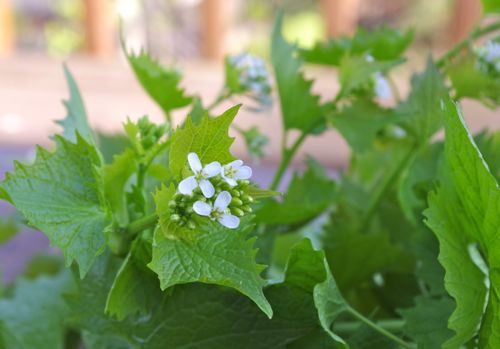
The leaves of the garlic mustard plant are easy to strip off, and can be tossed in salads or cooked (very gently). I prefer to make them into a delightfully strong pesto, which can then be used in a variety of ways: with pasta, in dressings, spread on bread, smeared on fish. I make it by guess, but I’ve included a rough recipe at the bottom of this page.
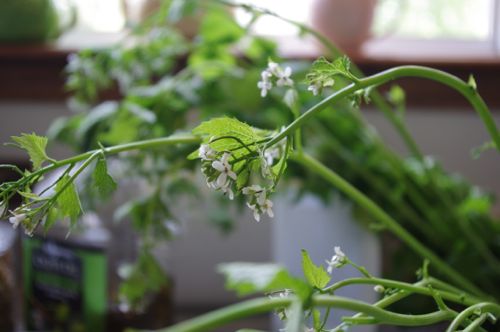
Some people will tell you to forage for fiddleheads. I say fiddlesticks to fiddleheads. They are hard to find and fussy to cook, and weirdly fleshy to eat. Begin with the easy things, and when you find that you are taking your dog on increasingly longer hikes to seek out the right shade for violets or an untouched patch of second-year garlic mustard, then you are ready to move beyond this guide. I recommend consulting Steve Brill, who styles himself “Wildman” but who is thorough and knowledgeable, and pleasant as well: www.wildmanstevebrill.com
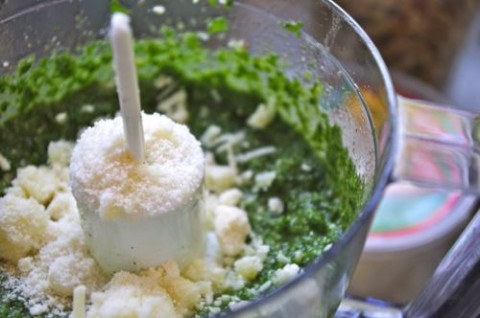
Recipes
Foraging seldom leads to exact quantities, so alter the proportions to suit what you have.
Pesto with Garlic Mustard Greens
This is a traditional Pesto alla Genovese, made zippier by the addition of wild greens.
1 cup Garlic Mustard Leaves
1 cup Basil Leaves
2 Cloves of Garlic, peeled
1/2 cup Walnuts (or pine nuts)
2/3 cup of Grated Parmesan and/or Romano Cheese
2/3 cup Olive Oil
1 teaspoon of Fresh Lemon Juice (optional)
Salt and Pepper to taste
Whiz these in a blender or food processor until finely chopped; taste and adjust.
Garlic Mustard Pesto
This is a more assertive pesto. Measurements are approximate; you should alter them to suit your tastes and your purpose.
3 cups of Garlic Mustard Greens (you can use the stems, too)
1 inch of Garlic Mustard Root, washed and trimmed
3 Cloves of Garlic
3/4 cup of Toasted Walnuts
3/4 cup of Grated Parmesan and/or Romano Cheese
3/4 cup of Walnut Oil (ideally, but olive will do)
Salt and Pepper to taste
A handful of chives (optional, but a nice oniony addition)
A big squeeze of lemon (optional, and you may not want the flavor, but it will help keep the pesto from turning brown with keeping)
Whiz until finely chopped; taste and adjust. It freezes very nicely in ice cube trays or in half-cup portions.
I like to spread this paste on fish before I grill or broil it. If I’m using salmon, I might blend a little honey & mustard into the pesto too; the resulting dish is as good cold as it is hot, and tastes vaguely Scandinavian to me. It’s a wonderful addition to a salad Nicoise, or to the salad my husband calls “Russian salad” because he ate it first in a Russian restaurant: greens, chopped hard-boiled egg, beets, tuna, cucumbers and sweet corn and scallions or even red onions, with a bit of crumbled mild cheese, dressed in a vinaigrette that’s heavy with garlic mustard pesto and anchovies.